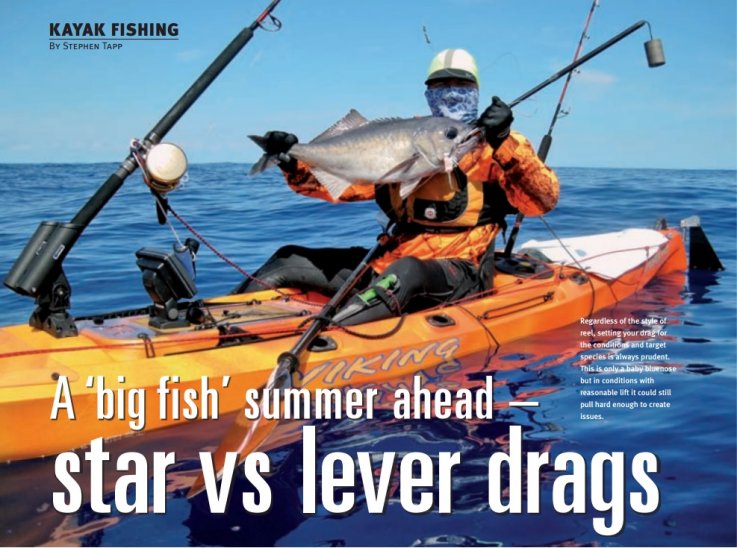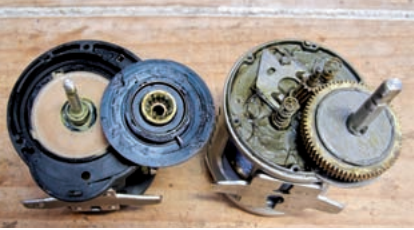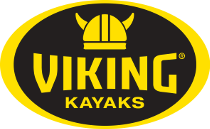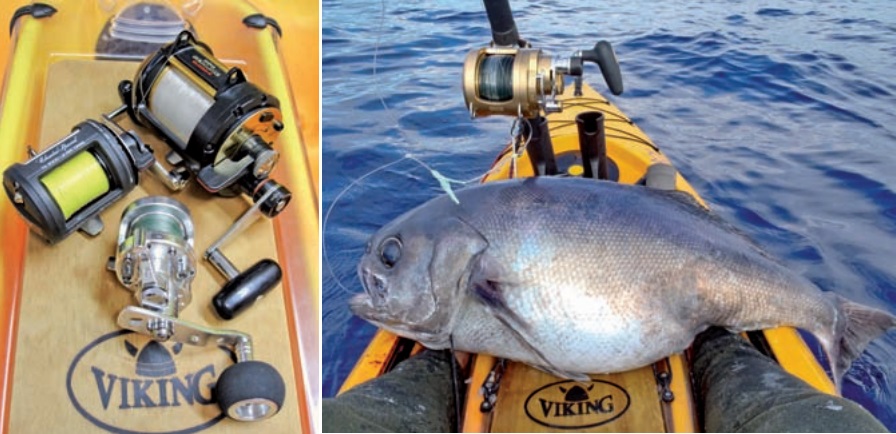Star vs Lever drags
12:03PM 19th Sep 13

Star vs lever drags (as published in the NZ Fishing News )
With many kayakers increasingly targeting bigger and bigger fish, there have been a lot more questions circulating about the relative performance and advantages of the two different drag systems available.
Something becoming increasingly evident is that many of the discussions I’m hearing are based on experiences gained when fishing from big boats, and often don’t take into account that the anglers asking the questions are fishing from kayaks. Kayaks introduce two significant variations on fishing from much larger craft, and these need to be considered when selecting suitable fishing tackle.
Specifically, the environment is considerably wetter (affecting reel performance) and it can be much more difficult to stay aboard when targeting powerful string pullers! In fact, when considering drag performance, these two factors can become inexorably linked if mixing it up with big fish in deep water and choppy conditions –wet drags often become jerky and unpredictable, and the ‘unpredictable’ part could easily have you over the side and into the water!
Having a smooth drag that won’t ramp up to un manageable pressures is critical to success when dealing with hard-pulling species such as kingfish and hapuku, especially when the battles inevitably turn vertical and you’re trying to gain line straight over the side of the kayak. In this situation any drag that jerks, is too strong, or binds tight, could have you dragged off the kayak in an instant. Any drag that suddenly releases pressure could have you unceremoniously dumped off the other side, too!
Waterlogged drags
One of the fastest ways to end up with an unmanageable drag is to get it waterlogged. With star-drag designs the assembly of drag washers is usually contained within the main gear, so a degree of protection from water contamination is gained by the way the assembly and gear are mounted to a bridge plate or web in the reel’s frame. This effectively shields the drag from direct splash and spray, and it takes a reasonable drowning to get serious water between the drag washers.
There is also the added advantage of better drainage if the reel is constantly being splashed (many reels have rainage holes in the side plate or frame). In contrast, lever-drag reels generally have their drag components mounted into one end of the spool, making the system more prone to getting wet. Many have a cover plate and seals to help keep water out, but given the relatively exposed position, water entry can still be a problem.
An unfortunate consequence of ‘sealing’ the drag area is that any water making it past the seal (not uncommon when fishing rough conditions from kayaks) is impossible to remove without stripping and servicing the reel. Since the water is then contained within the drag assembly, even the smallest amount can create a nightmarishly jerky result. One way I’ve managed to limit water issues with both drag systems has been to convert them to ‘wet drags’.
In this context ‘wet’ has nothing to do with water; it means oiling or greasing the fibre washers instead of running them dry. This isn’t possible with all types of material though, so it may mean having to change the drag washers – but having the oil/grease present makes it easier to exclude water and maintain a smooth drag system.
Left: Lever drag reels are available in a range of sizes and are capable of phenomenal drag performance. The diminutive Ducro 10 and the Charter Special make excellent snapper and kingfish reels but still need to be treated with as much respect as Daiwa game reel in the background. Right: Big bluenose, such as this one, make drag management critical. With lever drag reels and heavier line classes it pays to adjust the preset ‘strike drag’ position according to conditions and your skill rather than arbitrarily setting itto a percentage of the line class
Setting the strike position
Another difference between the two systems is based around the way they operate and the need to set the ‘strike-drag’ setting on lever-drag reels. The major issue arises when using line classes of 15kg and heavier. Many kayak anglers are setting their drags to 30% of the line class in accordance to common practice amongst boaties. Unfortunately, this takes no account of the conditions being fished on the day or the pressure an angler can safely exert without disappearing over the side (calm days equal more pressure; rough days equal less pressure).
The risk with arbitrarily setting the strike drag based only on line class occurs when a larger than-expected fish is hit with the lever at the strike position, and you suddenly find yourself with too much pressure to manage. If any swell or chop combines with a too-heavy setting, the trip over the side will happen even faster! In my opinion, the trick is to be prepared to constantly alter the strike drag based on the conditions, rather than trying to base it on a pre-ordained percentage of line class.
Watch out for free-spool!
Another potential problem when working with lever drags is how easy it is to inadvertently hit free-spool while reducing pressure, or to knock it out of gear in the hurly-burly of landing a big fish. If an overrun (birds-nest) is created, the inevitable result is all sorts of grief. Away round this is to always put the clicker on for the last part of the battle. It can be noisy, and your mates may give you a hard time for doing a Hollywood, but there’s nothing like a noisy clicker for limiting the damage if that lever hits free spool! I’m not just picking on lever-drag reels; star-drag reels can also be a problem if you forget to check your drag before letting out line – there’s nothing like flipping the reel into gear and finding everything locks up way too tight when hooked to a submarine!
Operator error can create some very interesting situations, so check those drags! As with the lever drags, when using star-drag reels to land big battlers like the Three Kings kingfish we encountered earlier this year, make sure you set the clicker for the last part of the battle. It’s then possible to instantly flip the reel out of gear without fear of a very messy overrun if you need to suddenly reduce pressure or give line (e.g. you have the fish gaffed but wound too close to the rod tip it’s easier to flip the reel out of gear one-handed than try to ramp back the drag).

Both these drags have been converted to greased “wet” drags for smoother performance and greater tolerance to water. The lever drag on the left has a waterproof cover plate to help stay dry, but on kayaks it doesn’t pay to rely on this.
So,which drag is best?
Both systems have their advantages, and both can cause grief if not managed correctly. I like star drags for enabling the drag pressure to be finely readjusted during battle and not having to worry about inadvertently hitting them into free-spool. However, I like lever-drag reels for their uncomplicated design and easy servicing but make a particular point of setting the ‘strike drag’ conservatively, based on conditions, before considering line class. With both systems I pay particular attention to the quality of the fibre washers used (it’s relatively inexpensive to upgrade if needed) and run them as wet drags using a purpose-specific grease such as Cal’s Drag Grease.
article by Stephen Tapp
Here is some of the dialogue from our Facebook post on this subject:
Stephen Tapp : This article has created some interesting debate at various shows I've done. Have a read and see what you think. As mentioned I like both, fish with both in a variety of line classes, but will always chose particular reels and drags to suit the fishing I'm intending for day.
Daniel Pye : Spinners all day.
Matthew Sutherland : Lever. I'm curious, why would anyone prefer star? Are they better for fine control or something?
Stephen Tapp : The debate over the relative merits of both drags will be on-going. I use both, like both, but will choose one over the other for different situations. I really like star drags when dealing with fish like big hoodlums (yellow tail) at the side of the kayak - I've seen several anglers in all sorts of trouble when they inadvertently knocked the lever into free-spool and ended up with a birdsnest.
Bryce Kerkhof : I prefer lever for heavier line classes and star for lighter
Shane Kelly: Lever drag can be a pain...easy to knock but I love JM PE5 "skull dragger"
NZ Kayaker : you never know what drag pressure you are applying with star drag - at least you can set a lever drag for strike and sunset before you head out on the water
Stephen Tapp : When fishing line classes 15kg and over I'm not too concerned with the absolute amount of drag I'm using, more the max amount of pressure I can apply to the fish in the conditions at the time without being pulled over the side. With these heavier line classes I have yet to bust a line because of too much drag, so setting the strike to a pre-determined level has never been important to me (biggest fish I've boated to the kayak to date is estimated at 150kg).
Rian Rapana : Depends on the task for me. Game trolling and light line class fishing, lever drag all the way, especially with mono. Casting soft baits etc, start drag, all the way. But that's just as much to do with the fact the small bait casters are all star drags rather than the drag style determining their use. Outside of those situations it just comes down to individual makes and models, I'll make a reel I like work!






